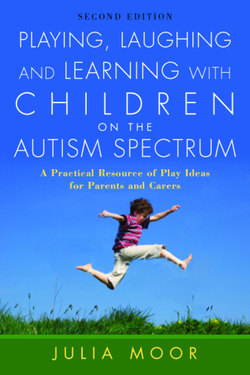Читать книгу Playing, Laughing and Learning with Children on the Autism Spectrum - Julia Moor - Страница 13
Ideas to try
ОглавлениеBalloons – Simple and often effective, try letting a blown-up balloon deflate and whiz around the room. Let your child anticipate when this will be by saying ‘ready, steady – go!’ Leave a pause before you let go of the balloon so that your child can anticipate the activity and be motivated to either attempt to say ‘go’ or make a gesture to communicate it to you such as making eye contact. Novelty shops often sell items powered by balloons, for example, cars that move along the floor or helicopters. These types of shops are not marketed towards very young children but are worth a visit for novelty items that your child would find difficult to ignore. Never leave such things where your child might get hold of them on his own as they may not be safe or have small parts that he may choke on – supervized play only! Try patting a blown-up balloon at your child; if he likes a particular object, draw it onto the surface (or stick a picture of it on the balloon).
Bubbles – There’s a multitude of different bubble-blowing machines/wands available. Don’t forget to wait for your child to make eye contact before you blow more bubbles. If your child wants to blow them too, choose something easy for him to handle (special no-spill containers are also available). If you are initially introducing bubbles to access your child’s attention and build motivation to communicate, it’s best to control the bubble-blowing yourself otherwise the game could soon dissolve into a solitary activity. However, later on, you may wish to use bubbles as a rewarding activity for attempting something more demanding. Encouraging your child to blow is good exercise for those speech muscles. If he’s having difficulty blowing, try one of the little battery-operated fan/bubble-blowers for instant impact (and easy for him to use, too). Also try the bubble wands with built-in fans/whistles. Watch out for the bottle of solution being more interesting than the bubbles! If your child likes containers of this type keep them out of sight and just hand him the wand. Avoid worrying about the carpet by putting towels on the floor so your attention isn’t diverted and you can really have fun. (For suppliers of bubble activities, see the Resources section at the back of the book.)
Feathers – Some children with autism find the soft touch of a feather very uncomfortable; others (like my son) find it fun to be tickled by it, and to use it to tickle me! Try the really big, brightly coloured plumes you find in sewing and craft shops. Don’t just launch at your child with it – play at tickling teddy/siblings/yourself until he starts to take notice and gently try it out on him, leaving long pauses to build up his anticipation.
Remember to make it easy for your child to establish eye contact. Get on your knees at eye level or even underneath your child’s eye level. Don’t make him have to look up at you.
Share your child’s chosen activity. If he runs about the room making noises, copy him! Act as if his behaviour is purposeful and meaningful. After you have imitated him for a while, pause and wait for a reaction. Leave plenty of spaces for him to react if he wants. Try introducing some variations of your own and encourage him to imitate you. You may wish to investigate Intensive Interaction strategies like this further, see the end of this chapter for more information.
If he is holding a toy, act as if he is showing it to you. Hold it up (though don’t necessarily take it out of his hands) and talk about it.
Jack-in-the-box-type toys – These ‘now you see them, now you don’t’-type toys are often aimed at babies but have the appeal of instant reward and increase motivation by building anticipation. My son loved the ‘frog in a box’ toy (by Galt – see Resources section at the back of the book).
Attention Grabbers Box – For sheer practicality, try putting together a box of props which you and others can use. I often came across silly novelties that looked like they had potential – some worked, some didn’t, but eventually I had a box of little secret weapons. I kept this out of my son’s reach. It wasn’t an all-purpose toy box. In it was a collection of things which included:
a spinning top
a feather
a glove puppet
a bubble machine
a party blower
a yoyo
a sticky ball (you threw it against a wall and it slid down slowly!)
some Sellotape (my son loved the sound)
a magnetic spinning dolphin.
You might try holding up two items and encouraging your child to point to which he wants – physically mould his hand into a point shape if necessary. Throughout the day encourage this when he goes to grab something, mould his hand into a point and then touch the item before giving him it. Reinforcethe gesture by saying, ‘Point to…[whatever it is he is requesting]’.
NOTE: Always be wary of including something your child likes to the point of obsession otherwise this becomes more important than you or the interaction!
